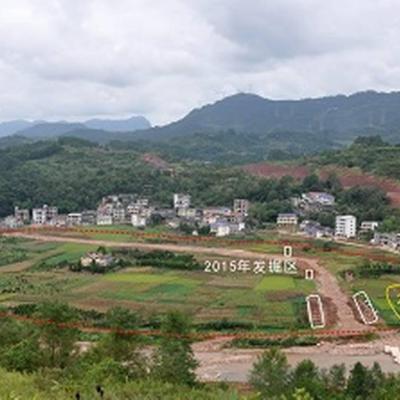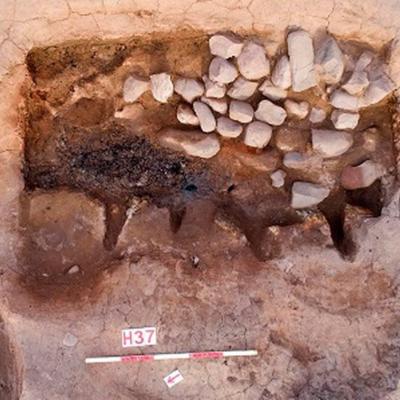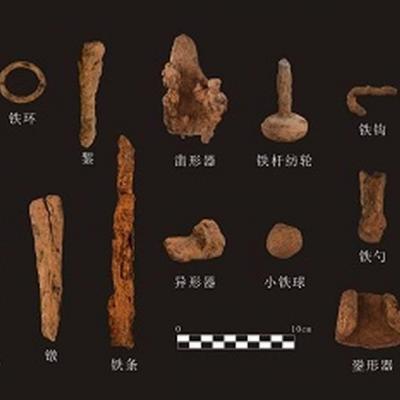Aspen Pflughoeft
Source - https://www.kansascity.com/news/nation-world/world/article272370378.html
 Archaeologists in Hunan province found ruins of an iron and copper production site filled with hundreds of furnaces and relics, photos show. Photo from the Hunan Provincial Institute of Cultural Relics and ArchaeologyTucked in the shadow of a mountain and under the soft green cover of grass lay the ruins of a once-bustling production site. Furnaces sat filled with cold ash. Tools remained haphazardly buried for centuries. Archaeologists began excavating the Guantian metalworking site in Zhujiaping years ago, but the full scale of the production site has only recently become clear, the Hunan Provincial Institute of Cultural Relics and Archaeology said in a Monday, Feb. 6, news release. At the massive site, archaeologists uncovered over 250 ash pits, remnants of furnaces and storage pits. The furnaces were underground or partially underground structures with a variety of shapes, some rectangular, some spoon-shaped. Most were filled with large stones covered in burn marks and small charcoal chips.
Archaeologists in Hunan province found ruins of an iron and copper production site filled with hundreds of furnaces and relics, photos show. Photo from the Hunan Provincial Institute of Cultural Relics and ArchaeologyTucked in the shadow of a mountain and under the soft green cover of grass lay the ruins of a once-bustling production site. Furnaces sat filled with cold ash. Tools remained haphazardly buried for centuries. Archaeologists began excavating the Guantian metalworking site in Zhujiaping years ago, but the full scale of the production site has only recently become clear, the Hunan Provincial Institute of Cultural Relics and Archaeology said in a Monday, Feb. 6, news release. At the massive site, archaeologists uncovered over 250 ash pits, remnants of furnaces and storage pits. The furnaces were underground or partially underground structures with a variety of shapes, some rectangular, some spoon-shaped. Most were filled with large stones covered in burn marks and small charcoal chips.
 An overview of the excavated metalworking site. Photo from the Hunan Provincial Institute of Cultural Relics and Archaeology
An overview of the excavated metalworking site. Photo from the Hunan Provincial Institute of Cultural Relics and Archaeology
The largest furnace was just over 8 feet long, the release said. Another furnace still had an iron kettle on it. Photos show the ruins. Fragments of copper and iron characteristic of in-process metal production indicated the site’s purpose.
 The largest furnace uncovered at the site. Photo from the Hunan Provincial Institute of Cultural Relics and Archaeology
The largest furnace uncovered at the site. Photo from the Hunan Provincial Institute of Cultural Relics and Archaeology
Over 120 ash ditches were also found at the metalworking site, archaeologists said. They were filled with discarded charcoal and other fragments, unwanted byproducts of metalworking production. Among the furnaces and ditches, researchers uncovered the ruins of 17 house sites. Some of these structures were near several furnaces, indicating they were likely workshops. Doorway remnants, tile fragments and broken pottery was also unearthed near the house structures.
 One of the workshops found at the site. Photo from the Hunan Provincial Institute of Cultural Relics and Archaeology
One of the workshops found at the site. Photo from the Hunan Provincial Institute of Cultural Relics and Archaeology
The iron and copper production site was used during the Han and Jin dynasties, the release said. The Han dynasty ruled China from 206 B.C. to 220 A.D., according to Britannica. The Jin, or Chin, dynasty followed soon after, ruling the region from around 265 to 420 A.D., per Britannica. The Guantian site is the largest known iron-working site in southern China from this time period. Production at Guantian began at least 1,600 years ago but may have been established as early as 88 A.D. when the Chinese emperor decided to expand iron production beyond officially designated sites, the release said.
 Another workshop found at the site. Photo from the Hunan Provincial Institute of Cultural Relics and Archaeology
Another workshop found at the site. Photo from the Hunan Provincial Institute of Cultural Relics and Archaeology
Archaeologists found numerous artifacts at the Guantian production site, primarily pottery, iron and copper items, metalworking tools and stone tools. Photos show some of the pottery items, such as pots, bowls, jugs and cups.
 Pottery artifacts found at the site. Photo from the Hunan Provincial Institute of Cultural Relics and Archaeology
Pottery artifacts found at the site. Photo from the Hunan Provincial Institute of Cultural Relics and Archaeology
Some of the iron production tools included forks, axes, chisels and knives. Other iron artifacts were household items such as kettles and belt hooks. A few weapons, such as swords and arrowheads, were also uncovered. Excavations at the Guantian site are ongoing, the release said. The next project will excavate about 37,000 square feet more of the site.
 Iron relics uncovered at the site. Photo from the Hunan Provincial Institute of Cultural Relics and Archaeology
Iron relics uncovered at the site. Photo from the Hunan Provincial Institute of Cultural Relics and Archaeology
Zhujiaping is in Hunan province and about 850 miles southwest of Shanghai.